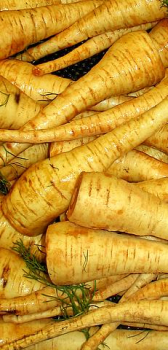
Eating Fresh Vegetables All Winter
 The
trick to keeping your storage vegetables fresh all winter is
understanding the type of conditions they prefer. Storage
conditions can be measured by temperature, humidity, ventilation, and
darkness. Nearly all crops like it dark and airy, but each
vegetable has a favorite range of temperature and humidity conditions.
The
trick to keeping your storage vegetables fresh all winter is
understanding the type of conditions they prefer. Storage
conditions can be measured by temperature, humidity, ventilation, and
darkness. Nearly all crops like it dark and airy, but each
vegetable has a favorite range of temperature and humidity conditions.
In practice, I divide
our storers up into two main categories --- cool, wet storers and warm,
dry storers. Cool, wet storers thrive in root cellars and can
also be kept well in simpler storage operations like mulched garden
rows, storage mounds ("clamps"), trenches, a basement, or the crisper
drawer in your fridge. Warm, dry storers will do much better in
your attic, an unheated room, or under your kitchen sink.
I'm vastly
oversimplifying by dividing crops into these two categories, but it's
far too easy to get carried away trying to provide a half dozen
different storage conditions to keep all of your crops happy. The
table below gives some storage data on common vegetables:
| Vegetable |
Optimal
storage conditions |
My storage
conditions |
My storage
location |
| Beet |
32 - 40 F, 90 - 95% humidity | cool, moist |
haven't done it yet |
| Cabbage |
32 - 40 F, 80 - 90% humidity | cool, moist |
haven't done it yet |
| Carrot |
32 - 40 F, 90 - 95% humidity |
cool, moist |
haven't done it yet |
| Garlic |
32 - 50 F, 60 - 70% humidity | warm, dry |
kitchen shelf |
| Onion |
32 - 50 F, 60 - 70% humidity | warm, dry |
kitchen shelf |
| Parsnip |
32 - 40 F, 90 - 95% humidity | cool, moist |
haven't done it yet |
| Potato |
32 - 40 F, 80 - 90% humidity | cool, moist |
storage mound |
| Sweet Potato |
50 - 60 F, 60 - 70% humidity |
warm, dry |
under the kitchen sink |
| Turnip |
32 - 40 F, 90 - 95% humidity | cool, moist |
haven't done it yet |
| Winter Squash (including Pumpkin) |
50 - 60 F, 60 - 70% humidity | warm, dry |
under the kitchen sink |
Despite ignoring some of the optimal conditions, I've had great luck keeping onions, winter squash, and sweet potatoes fresh until they're all eaten up. (In fact, we still have some of last year's sweet potatoes to finish up as this year's are curing!) Don't get too caught up in thinking you have to build a fancy root cellar before you can enter the world of storage vegetables.
| This post is part of our Storage Vegetables lunchtime series.
Read all of the entries: |
Want more in-depth information? Browse through our books.
Or explore more posts by date or by subject.
About us: Anna Hess and Mark Hamilton spent over a decade living self-sufficiently in the mountains of Virginia before moving north to start over from scratch in the foothills of Ohio. They've experimented with permaculture, no-till gardening, trailersteading, home-based microbusinesses and much more, writing about their adventures in both blogs and books.
Want to be notified when new comments are posted on this page? Click on the RSS button after you add a comment to subscribe to the comment feed, or simply check the box beside "email replies to me" while writing your comment.
